
Betula nigra, the black birch, river birch or water birch, is a species of birch native to the Eastern United States from New Hampshire west to southern Minnesota, and south to northern Florida and west to Texas. It is one of the few heat-tolerant birches in a family of mostly cold-weather trees which do not thrive in USDA Zone 6 and up. B. nigra commonly occurs in floodplains and swamps.
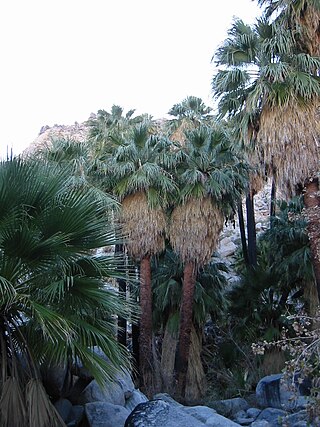
Washingtonia filifera, the desert fan palm, California fan palm, or California palm, is a flowering plant in the palm family Arecaceae, native to the far southwestern United States and Baja California, Mexico. Growing to 15–20 m (49–66 ft) tall by 3–6 m (10–20 ft) broad, it is an evergreen monocot with a tree-like growth habit. It has a sturdy, columnar trunk and waxy, fan-shaped (palmate) leaves.

Carpinus caroliniana, the American hornbeam, is a small hardwood understory tree in the genus Carpinus. American hornbeam is also known as blue-beech, ironwood, musclewood and muscle beech. It is native to eastern North America, from Minnesota and southern Ontario east to Maine, and south to eastern Texas and northern Florida. It also grows in Canada. It occurs naturally in shaded areas with moist soil, particularly near the banks of streams or rivers, and is often a natural constituent understory species of the riverine and maritime forests of eastern temperate North America.

Sotol is a distilled spirit from the Chihuahuan desert sourced from the plants of the genus Dasylirion, most commonly: Dasylirion wheeleri, Dasylirion durangense,Dasylirion cedrosanum, and Dasylirion leiophyllum, less commonly with Dasylirion texanum and Dasylirion lucidum, plants that grow in the Chihuahuan desert of northern Mexico, New Mexico, Arizona, and west and central Texas. Sotol liquor is known as the state spirit of Chihuahua; however, the drink is also consumed in Durango and Coahuila. Sotol has its own appellation of origin since 2002, and may be produced only in Chihuahua, Coahuila and Durango. There are dozens of commercial examples available. Production of sotol spirits exists outside the Sotol Denomination of Origin in several regions such as Sonora where it is known as Palmilla, Oaxaca (Cucharillo), and the Texas Hill Country. With Sotol on the rise in terms of its popularity, more brands are beginning to come onto the scene.

Dasylirion wheeleri is a species of flowering plant in the asparagus family (Asparagaceae), native to arid environments of northern Mexico and the southwestern United States.
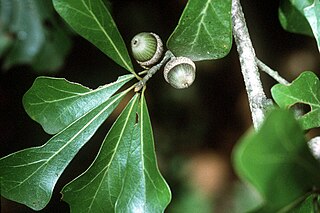
Quercus nigra, the water oak, is an oak in the red oak group, native to the eastern and south-central United States, found in all the coastal states from New Jersey to Texas, and inland as far as Oklahoma, Kentucky, and southern Missouri. It occurs in lowlands and up to 450 meters in elevation.
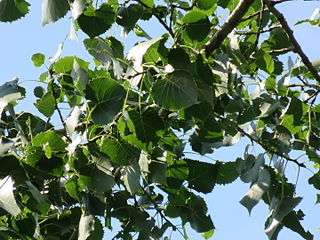
Populus deltoides, the eastern cottonwood or necklace poplar, is a species of cottonwood poplar native to North America, growing throughout the eastern, central, and southwestern United States as well as the southern Canadian prairies, the southernmost part of eastern Canada, and northeastern Mexico.
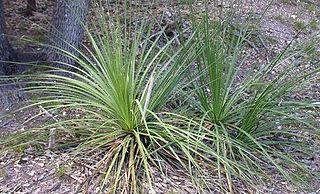
Dasylirion texanum, the Texas sotol and sotol, is a monocot flowering plant native to central and southwestern Texas and in Coahuila state of northeastern Mexico, including the Chihuahuan Desert.
Juniperus coahuilensis, commonly known as redberry juniper, is a species of conifer in the family Cupressaceae.

Fraxinus profunda, the pumpkin ash, is a species of ash (Fraxinus) native to eastern North America, where it has a scattered distribution on the Atlantic coastal plain and interior lowland river valleys from the Lake Erie basin in Ontario and New York west to Illinois, southwest to Missouri and southeast to northern Florida. It grows in bottomland habitats, such as swamps, floodplains and riverbanks. It is threatened by the emerald ash borer, an invasive insect which has caused widespread destruction of ash trees in eastern North America.

Sabal palmetto, also known as cabbage palm, cabbage palmetto, sabal palm, blue palmetto, Carolina palmetto, common palmetto, Garfield's tree, and swamp cabbage, is one of 15 species of palmetto palm. It is native to the far Southeast United States, the Yucatán Peninsula in Mexico, the West Indies, and the Bahamas.

Malva multiflora is a species of flowering plant in the mallow family known by the common names Cornish mallow and Cretan hollyhock. It is native to western Europe, North Africa, and the Mediterranean Basin, and it is naturalized in areas with a Mediterranean climate, such as parts of Australia, South Africa, and California. This is an annual or biennial herb growing a tough, somewhat hairy stem to a maximum height between 1 and 3 meters. The leaves are multilobed with flat or wavy edges, slightly hairy, and up to 10 centimeters long. The plant bears small pink or light purple flowers with petals just over a centimeter long. The fruit is disc-shaped with 7 to 10 segments.

Arctostaphylos pungens, with the common name pointleaf manzanita, is a species of manzanita. It is native to the Southwestern United States and to northern and central Mexico, where it grows in chaparral and woodland habitats, and on desert ridges. Arctostaphylos pungens can be seen growing at Tent Rocks National Monument in New Mexico at an elevation of about 6000 feet.

Quercus pagoda, the cherrybark oak, is one of the most highly valued red oaks in the southern United States. It is larger and better formed than southern red oak and commonly grows on more moist sites. Its strong wood and straight form make it an excellent timber tree. Many wildlife species use its acorns as food, and cherrybark oak makes a fine shade tree. Cherrybark oak was formerly considered to be a subspecies of southern red oak, Quercus falcata, subsp pagodifolia.

Dasylirion longissimum, the Mexican Grass Tree, is a species of flowering plant native to the Chihuahuan Desert and other xeric habitats in Northeastern Mexico.
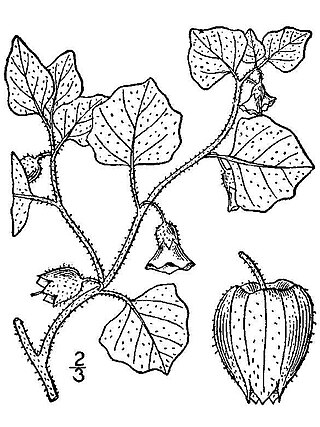
Physalis hederifolia is a species of flowering plant in the nightshade family known by the common name ivyleaf groundcherry. It is native to the southwestern United States and northern Mexico, where it can be found in rocky, dry desert and mountain habitat. This is a rhizomatous perennial herb producing a hairy, branching stem 10 to 80 centimeters long. The gray-green oval leaves are 2 to 4 centimeters long and have smooth or bluntly toothed edges. The flowers growing from the leaf axils are bell-shaped and just over a centimeter long. They are yellow with five brown smudges in the throats. The five-lobed calyx of sepals at the base of the flower enlarges as the fruit develops, becoming an inflated, veined nearly spherical structure 2 or 3 centimeters long which contains the berry.

Quercus arizonica, the Arizona white oak, is a North American tree species in the beech family. It is found in Arizona, New Mexico, western Texas, Sonora, Chihuahua, Coahuila, Sinaloa, and Durango.
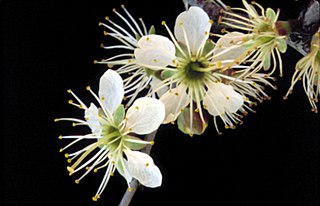
Prunus geniculata is a rare species of plum known by the common name scrub plum. The species is endemic to Florida.

Flourensia cernua is a species of flowering plant in the aster family known by the English common names American tarwort and tarbush and the Spanish common names hojasé, hojasén, and hoja ancha. It is native to the Chihuahuan Desert of North America, where it occurs in the US states of Arizona, New Mexico, and Texas, and the Mexican states of Sonora, Chihuahua, Coahuila, Durango, San Luis Potosí, and Zacatecas. Most of the species in the genus are found in Latin America; this and F. pringlei are the only two species whose ranges extend into the United States.

The Sierra del Carmen, also called the Sierra Maderas del Carmen, is a northern finger of the Sierra Madre Oriental in the state of Coahuila, Mexico. The Sierra begins at the Rio Grande at Big Bend National Park and extends southeast for about 72 kilometres (45 mi), reaching a maximum elevation of 2,720 metres (8,920 ft). Part of the Sierra del Carmen is protected in the Maderas del Carmen Biosphere Reserve as part of a bi-national effort to conserve a large portion of the Chihuahua Desert in Mexico and Texas.




















